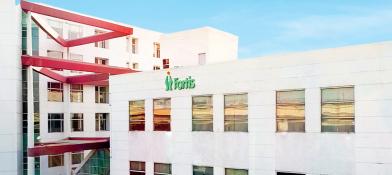Light therapy
Overview:
Light therapy (phototherapy) treatment uses ultraviolet light on exposed skin to treat various skin disorders. It is a significant and effective treatment modality used in dermatology. Light therapy uses the ultraviolet (UV) spectrum of electromagnetic radiation. The ultraviolet spectrum belongs to nonionizing radiation.
UV light produced by the sun helps synthesize vitamin D in our body. The UV light in phototherapy is the same wavelength as that produced naturally. Healthcare providers generally decide the light strength and the duration to which one can be exposed.
Types of Light therapy:
Phototherapy in dermatology uses ultraviolet light in different wavelengths like ultraviolet A (UV A), ultraviolet B (UV B), or a combination of both. These UV lights travel in different wavelengths to help treat various skin conditions. These different wavelengths have different properties and react differently when exposed to skin.
- UV B light has a medium wavelength ranging from 280-320 nm. This is delivered as a Broadband UV spectrum ranging from 270-350nm or a narrow band UV spectrum with a wavelength between 311-313 nm. It targets the outer skin layers, diminishing inflammation by inhibiting the immune response. It impacts T-lymphocytes and keratinocytes implicated in skin conditions.
- UV A has longer wavelengths ranging from 320 nm to 400nm. UV A 1 has a wavelength ranging from 340 and 400 nm. UV A affects the first two layers of the skin. UV A is delivered with a psoralene sensitizer called PUVA. It penetrates deeper layers of skin and treats skin disorders. PUVA affects the cross-linking of DNA, has immunosuppressive effects on T lymphocytes, and promotes collagenases and cytokines, leading to skin softening.
- Phototherapy is used to treat skin conditions like jaundice, and blue light therapy is used. These give a blue hue of light when exposed. The other type of phototherapy uses red light to treat skin conditions like wrinkles, redness, acne, and scars. These lights use a red hue of light.
Indications of Light therapy:
Phototherapy is indicated for various skin disorders like psoriasis, chronic eczema, mycosis fungoides, vitiligo, polymorphic light eruption, cutaneous graft versus host diseases, and generalized lichen planus. It is indicated in conditions that can manage symptoms, reduce inflammation, improve the appearance of skin, and when other treatment modalities have not been effective or are not suitable.
- For conditions like psoriasis and eczema narrow band UVB is preferred over broadband UVB.
- PUVA is indicated in some skin conditions when UVB alone is not sufficient.
- Narrow-band UVB (NB UVB) is also prescribed in pregnant patients, along with topical retinoids, vitamin D analogues, and steroids.
- NB UVB is prescribed as first-line therapy for generalized atopic eczema, and topical PUVA is advised for localized palmoplantar eczema.
- NB UVB and PUVA are effectively used in cutaneous T-cell lymphoma.
Contraindications:
There are specific absolute and relative contraindications for light therapy. In certain skin conditions like systemic lupus erythematosus (SLE) and dermatomyositis, syndromes like Bloom syndrome and genetic cancer syndromes, individuals who cannot follow the safety procedures, and individuals who are not medically fit and have life-threatening conditions.
History of previous exposure to ionizing radiation, cancers like melanoma, pregnancy, individuals on immunosuppressive therapy, cataracts, liver dysfunction, age less than 16 years, and light-induced epilepsy.
Before light therapy:
Before undergoing Light therapy, an individual should give complete information about medical history, medications being used like aspirin, isotretinoin, skin diseases, and past light treatments. Photographs might be taken to compare before with after. Protective wear like eye goggles, additional covering for genitalia, and face shields will be given before entering the light cabinet.
A dose assessment will be done based on the cause for which light therapy was indicated after that sample dose, called the phototoxic dose or minimal erythema dose testing is done. Sunscreen has to be applied to the areas where light therapy will be done.
During light therapy:
After wearing the protective gear and applying the sunscreen, an individual is taken into a chamber that contains the light. One will stand in a box-like chamber where a particular wavelength of light is passed onto the skin. Depending on the cause, the provider will adjust the intensity and duration of exposure. UVB and UVA are similar, except that a psoralen bath or cream is applied all over the body in UVA. Psoralen is a chemical derived from plants that increases the sensitivity to UVA light. If the area to be treated is small, the provider may focus the light on it with a wand.
After the therapy:
After the therapy, taking care of the exposed area by covering it with a cloth and using sunscreen is necessary. It is advisable to use protective eyewear when outside and use a moisturizer when going outdoors to prevent dry skin development.
Benefits of light therapy:
Light therapy has the advantage of reducing itchiness, redness, and inflammation and prevents the flare of symptoms in various skin disorders.
Risks and contraindications:
There are certain potential risks associated with light therapy. Redness and burning sensation are the common side effects seen in fair-skinned or obese individuals or those on certain medications when using UVB therapy. These peak in a day and can be subsided by steroid creams. Occasionally, herpes outbreaks are seen in those with previous skin infections. PUVA also causes redness and blisters on the skin.
Premature aging, dryness, wrinkles, and skin pigmentation changes are some of the long-term effects of light therapy. Light therapy increases skin cancer risk as it affects the immune system. Occasionally, cataracts of the eye also develop in those who are at risk.
Conclusion:
Light therapy, also known as phototherapy, is a widely used for various skin conditions. It exposes the skin to specific wavelengths of ultraviolet light to reduce inflammation, improve symptoms, and enhance the appearance of the skin. Light therapy can be effective, primarily when other treatments have not worked or are unsuitable for the individual.





























